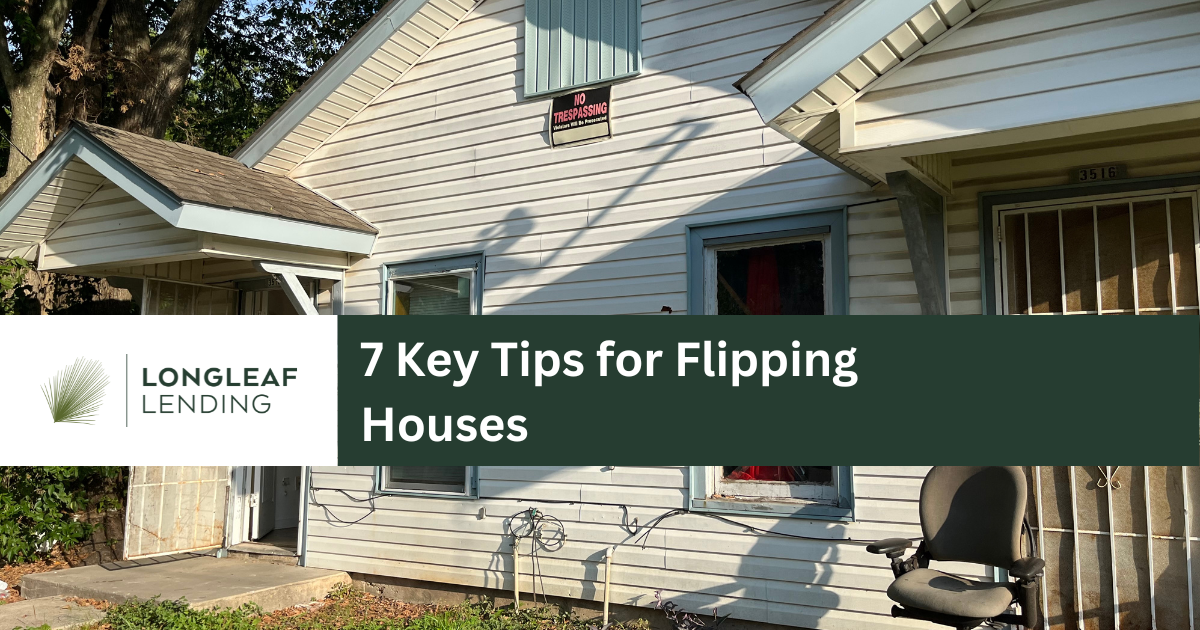
7 Key House Flipping Tips for Real Estate Investors
Will your flip turn into a flop? House flipping, like any other real estate venture, can be rewarding but has its own share of risks. Whether or not you have been in the business for a while or are just starting out, check out our 7 important tips to keep in mind before embarking on a house flip project.
1. Define partnerships properly
When starting a house flipping project with a partner, the a problem can arise when these partnerships are not well-defined. There are partnerships that are merely oral or “handshake agreements”.
”Without proper protections and a thoroughly defined list of responsibilities, the partnerships will not be successful and could result in redundant efforts, passing of responsibilities, and other issues that could result in time delays. And in real estate investing, time is the enemy of this business.”
Pete Underwood
Pete is Longleaf Lending’s co-founder and Managing Partner. He has over 14 years of experience in real estate investing.
He also advises that before entering a partnership, you need to ask yourself what would happen if things go bad? What are the penalties for each erring party? Thing about the things that can go wrong, and define in your partnership agreement what will happen if those events occur. For example:
- What happens if one partner wants to leave the partnership? Is there a buyout?
- What happens if a partner doesn’t fulfill their clearly defined responsibilities, such as paying for the loan interest?
You can read more about Pete’s advice here.
2. Know Your Numbers
“The most important thing when it comes to flipping is the first step and it's done before you purchase the home. It is knowing your numbers. You have to make sure your ARV is right. If not, all your other numbers will not make sense and you will more than likely lose money.”
Keith Moore
Keith has completed over 35 flips in the last 3 years of real estate investing. Prior to real estate investing Keith worked as a licensed real estate agent and completed more than 225 real estate transactions.
What is ARV in real estate house flipping?
After-Repair-Value or ARV is the estimated value of a real estate property after all the renovations have been completed. ARV is used by real estate investors to compare a property’s all in costs and what the property value should be when the project is complete. Is there enough profit potential?
You also need to assess the “comps” or comparables. These are properties that have sold in the neighborhood and are comparable in property age, condition, size, and style. If you could find 3-5 comparable properties, take note of their average sale price since that would give you an idea what your ARV would look like.
What is the 70% rule in ARV?
The 70% rule in ARV is a universal rule of thumb. Even though every flip is different, you should never pay for more than 70% of the property’s ARV minus the Estimated Repair Cost (ERC). For example, if a property’s ARV is $300,000 and it requires $20,000 in repairs, you should pay no more than $190,000 for the property.
(ARV x 70%) – estimated repair cost = maximum purchase target
Sample calculation:
- $300,000 (ARV) x .7 (70%) = $210,000
- $210,000 – $20,000 (ERC) = $190,000
3. Don’t step up the value too soon.
Another piece of advice from Pete Underwood:
For new flippers, start with the easy rehab first before working your way up to more complex projects. Do not take on luxury projects unless you have accumulated enough experience, construction background, liquidity, and capital.”
Pete Underwood
Pete advises real estate investors who are still starting out to start at the 300k range (average home price now in Houston is 400k) and take on projects that are more cosmetic in nature.
Stay away from projects that require moving walls, big foundation issues, redoing wiring, electrical, major plumbing, adding square footage, etc. These things play into other contractors’ work and become a more complex job that requires a lot of coordination. There is a high chance that your budget may blow through the roof.

4. Work with Contractors You Know
Keith Moore advises home flippers to work with contractors you have already worked with in the past. You will need to see if they can give you cost effective proposals where you can save money. Another important point? Look for contractor partners that can grow with you over the long-term and make more money alongside.
This partnership will be a win-win for both as you provide the contractor with a steady source of income from your business while you get to maximize your profits if they provide you with lower fees.
5. Get creative in looking for properties to flip
In competitive house flipping markets, you will likely have difficulty finding good properties to flip if you rely mostly on Multiple Listing Services. You will need to find better ways to look for properties such as joining a wholesaler’s email list, local auction email lists, social media groups, talk to realtors, or perhaps use online ads to market to sellers. Get creative!
Cold calling properties in a market you understand very well takes effort, but it will pay off in the long term.

6. Have a house flipping exit strategy in place
Always plan for the worst by having a contingency in place before you start to commit to a project. In the event that things go wrong and the flip drags on longer than you expected or your funds start to be depleted, you need to make a quick decision to cut your losses.
Remember, time is the enemy of this business.
For example, an exit strategy could be lowering the price even if you have to sell at a loss. Or you can become a landlord and rent or lease the property.
7. Assume that many things would go wrong
Related to the previous tip, you need to dial down the optimism when starting to work on a flip. Always assume beforehand that things could go wrong so never overestimate your capabilities and never underestimate the length of time you will hold the property.
In flipping, time is money. The longer your timeline gets dragged out, the more your budget gets stretched. So always be realistic about your expectations and budget for more.
Flipping a property requires a lot of planning and preparation. It is not risk free. But if done right, it will be very rewarding. See some of our case studies here and here for some insights into actual flips done by Longleaf Lending clients.
Planning to flip a property? At Longleaf, we offer various types of real estate loans including Fix and Flip and we can help fund your project in as little as two days. For more information, check out our loan products here or submit a loan request today.
